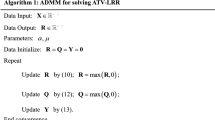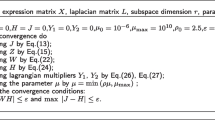Abstract
The tremendous development of single-cell RNA sequencing (scRNA-seq) technology offers the promise of addressing cellular heterogeneity problem which cannot be addressed with bulk sequencing technologies. However, scRNA-seq data is noisy and sparse due to the dropout events. In this study, we focused on cellular heterogeneity problem and proposed a hierarchical clustering algorithm based on optimal low rank matrix completion (HOMC). We first applied nonnegative matrix factorization for determining optimal low rank approximation for the original scRNA-seq data. Then we performed hierarchical clustering based on correlation-based distance for grou** those imputed data points, and optimal number of clusters can be determined by integrating three classical measures. Experimental results have showed that HOMC is capable of distinguishing cellular differences and the clustering performance is superior to other state-of-the-art methods.
Access this chapter
Tax calculation will be finalised at checkout
Purchases are for personal use only
Similar content being viewed by others
References
Kalisky, T., Quake, S.R.: Single-cell genomics. Nat. Methods 8(4), 311–314 (2011)
Pelkmans, L.: Using cell-to-cell variability – a new era in molecular biology. Science 336(6080), 425–426 (2012)
Patel, A.P., Tirosh, I., Trombetta, J.J., et al.: Single-cell RNA-seq highlights intratumoral heterogeneity in primary glioblastoma. Science 344(6190), 1396–1401 (2014)
Tirosh, I., et al.: Dissecting the multicellular ecosystem of metastatic melanoma by single-cell rna-seq. Science 352(6282), 189–196 (2016)
Wagner, A., Regev, A., Yosef, N.: Revealing the vectors of cellular identity with single-cell genomics. Nat. Biotechnol. 34(11), 1145–1160 (2016)
Trapnell, C.: Defining cell types and states with single-cell genomics. Genome Res. 25(10), 1491–1498 (2015)
Biase, F.H., Cao, X., Zhong, S.: Cell fate inclination within 2-cell and 4-cell mouse embryos revealed by single-cell rna sequencing. Genome Res. 24(11), 1787–1796 (2014)
Trapnell, C., et al.: Pseudo-temporal ordering of individual cells reveals dynamics and regulators of cell fate decisions. Nat. Biotechnol. 32(4), 381 (2014)
AlJanahi, A.A., Danielsen, M., Dunbar, C.E.: An introduction to the analysis of single-cell rna-sequencing data. Mol. Therapy-Methods Clin. Dev. 10, 189–196 (2018)
Kharchenko, P.V., Silberstein, L., Scadden, D.T.: Bayesian approach to single-cell differential expression analysis. Nat. Methods 11(7), 740–742 (2014)
Tracy, S., Yuan, G.-C., Dries, R.: Rescue: imputing dropout events in single-cell rna-sequencing data. BMC Bioinform. 20(1), 388 (2019)
Hou, W., Ji, Z., Ji, H., Hicks, S.C.: A systematic evaluation of single-cell rna-sequencing imputation methods, bioRxiv (2020)
Li, W.V., Li, J.J.: An accurate and robust imputation method scimpute for single-cell rna-seq data. Nat. Commun. 9(1), 1–9 (2018)
Chen, M., Zhou, X.: Viper: variability-preserving imputation for accurate gene expression recovery in single-cell rna sequencing studies. Genome Biol. 19(1), 1–15 (2018)
Gong, W., Kwak, I.-Y., Pota, P., Koyano-Nakagawa, N., Garry, D.J.: Drimpute: imputing dropout events in single cell rna sequencing data. BMC Bioinform. 19(1), 1–10 (2018)
Van Dijk, D., et al.: Recovering gene interactions from single-cell data using data diffusion. Cell 174(3), 716–729 (2018)
Talwar, D., Mongia, A., Sengupta, D., Majumdar, A.: Autoimpute: Autoencoder based imputation of single-cell rna-seq data. Sci. Rep. 8(1), 1–11 (2018)
Mongia, A., Sengupta, D., Majumdar, A.: Mcimpute: Matrix completion based imputation for single cell rna-seq data. Front. Genet. 10, 9 (2019)
Zhu, K., Anastassiou, D.: 2dimpute: imputation in single-cell rna-seq data from correlations in two dimensions. Bioinformatics 36(11), 3588–3589 (2020)
Gunady, M.K., Kancherla, J., Bravo, H.C., Feizi, S.: scgain: Single cell rna-seq data imputation using generative adversarialnetworks, bioRxiv, p. 837302 (2019)
Hartigan, J.A., Wong, M.A.: Algorithm as 136: A k-means clustering algorithm. Appl. Stat. 28(1), 100–108 (1979)
Lloyd, S.: Least squares quantization in pcm. IEEE Trans. Inform. Theory 28(2), 129–137 (1982)
Ng, A.Y., Jordan, M.I., Weiss, Y.: On spectral clustering: analysis and an algorithm. In: Advances in Neural Information Processing Systems, pp. 849–856 (2002)
Shao, C., Hofer, T.: Robust classification of single-cell transcriptome data by nonnegative matrix factorization. Bioinformatics 33(2), 235–242 (2017)
Lv, D., et al.: Systematic characterization of lncrnas’ cell-to-cell expression heterogeneity in glioblastoma cells. Oncotarget 7(14), 18403 (2016)
Kim, D.H., et al.: Single-cell transcriptome analysis reveals dynamic changes in lncrna expression during reprogramming. Cell Stem Cell 16(1), 88–101 (2015)
Camp, J.G., et al.: Multilineage communication regulates human liver bud development from pluripotency. Nature 546(7659), 533–538 (2017)
Peng, T., Nie, Q.: Somsc: self-organization-map for high dimensional single-cell data of cellular states and their transitions, bioRxiv, p. 124693 (2017)
Kiselev, V.Y., et al.: Sc3: consensus clustering of single-cell rna-seq data. Nat. Methods 14(5), 483–486 (2017)
Sun, Y., Babu, P., Palomar, D.P.: Majorization minimization algorithms in signal processing, communications, and machine learning. IEEE Trans. Signal Process. 65(3), 794–816 (2017)
Calinski, T., Harabasz, J.: A dendrite method for cluster analysis. Commun. Stat. 3(1), 1–27 (1974)
Davies, D.L., Bouldin, D.W.: A Cluster Separation Measure. IEEE Computer Society (1979)
Peter, R.J.: Silhouettes: a graphical aid to the interpretation and validation of cluster analysis. J. Comput. Appl. Math. 20, 53–65 (1999)
Lin, P., Troup, M., Ho, J.W.: Cidr: ultrafast and accurate clustering through imputation for single-cell rna-seq data. Genome Biol. 18(1), 59 (2017)
Xu, C., Su, Z.: Identification of cell types from single-cell transcriptomes using a novel clustering method. Bioinformatics 31(12), 1974–1980 (2015)
Kiselev, V.Y., Kirschner, K., Schaub, M.T., et al.: SC3: consensus clustering of single-cell RNA-seq data. Nat. Methods 14(5), 483–486 (2017)
Acknowledgments
This work was supported in part by the National Natural Science Foundation of China (Grant nos: 11801434, 11901575, 91730301, 62002234), China Postdoctoral Science Foundation (Grant no: 3115200128), Guangdong Basic and Applied Basic Research Foundation (Grant no: 2019A1515111180). The authors would like to thank the anonymous reviewers for helpful and constructive comments.
Author information
Authors and Affiliations
Corresponding authors
Editor information
Editors and Affiliations
Rights and permissions
Copyright information
© 2021 Springer Nature Switzerland AG
About this paper
Cite this paper
Cheng, X., Yan, C., Jiang, H., Qiu, Y. (2021). HOMC: A Hierarchical Clustering Algorithm Based on Optimal Low Rank Matrix Completion for Single Cell Analysis. In: Huang, DS., Jo, KH., Li, J., Gribova, V., Premaratne, P. (eds) Intelligent Computing Theories and Application. ICIC 2021. Lecture Notes in Computer Science(), vol 12838. Springer, Cham. https://doi.org/10.1007/978-3-030-84532-2_7
Download citation
DOI: https://doi.org/10.1007/978-3-030-84532-2_7
Published:
Publisher Name: Springer, Cham
Print ISBN: 978-3-030-84531-5
Online ISBN: 978-3-030-84532-2
eBook Packages: Computer ScienceComputer Science (R0)




